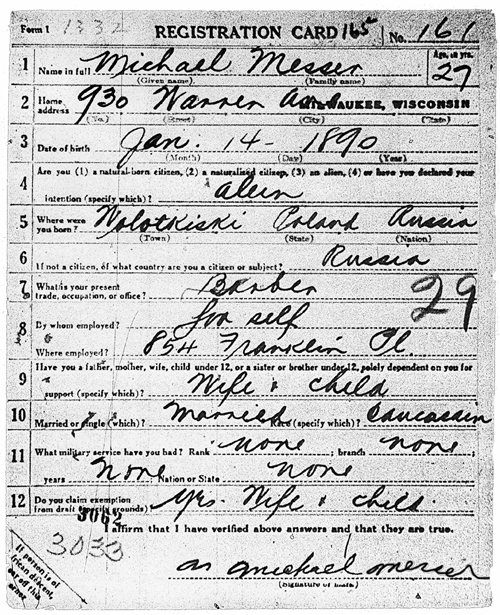|
SELECTIVE SERVICE RECORDS |
| Clearly, the registration of all males born in the last quarter
of the nineteenth century has significance for most family historians,
not just those seeking immigrants. However, given the coverage, most
recent immigrants will also be among those 24 million registrations.
Even if the immigrants had only recently arrived in America, if they
were of the required ages, they were supposed to register.
See sample below: Registration was done at three separate times, each involving a different group of men, and the information requested on the Draft Registration Card varied slightly. However, the following information was common to all registrations: Name Most registrants were also asked their naturalization status, their occupation, as well as the nearest relative's name and address. As with every government form, some did not fill it out completely, or wrote simply Russia (or some other country) for the specific birthplace. However, the vast majority of men provided complete birth date and birthplace information. Unlike previous semesters where the registration cards were not indexed, this class can now find ancestors indexed at www.Ancestry.com. It is generally easy to locate a person's registration. This helped greatly in large cities which were more difficult. The cards are arranged alphabetically by the registrant's name, within each draft board. Each county had at least one draft board. Counties with populations greater than about 30,000 had multiple draft boards. New York City had 189 local boards. Even in the more densely populated areas, you could find the registration card if you know where the man lived. This, again, points out the importance of knowing as much information as you can about the immigrant, before searching records such as these. In cities, use directories to learn the address where the family lived in 1917 and 1918. Once you know the address of the family, you can obtain a microfilm
from the Family History Library of Lists of World War I Draft Board
Maps showing the boundaries in most major cities. The library also
has addresses of the draft boards in most cities, from which you
can select the two or three boards nearest an ancestor's address.
|
|
|
